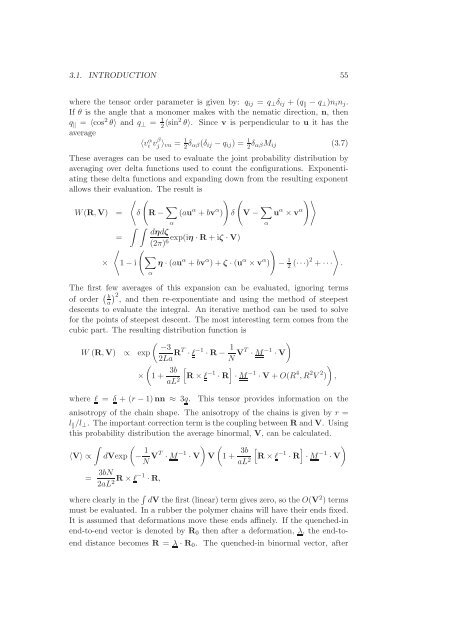Statistical models of elasticity in main chain and smectic liquid ...
Statistical models of elasticity in main chain and smectic liquid ...
Statistical models of elasticity in main chain and smectic liquid ...
Create successful ePaper yourself
Turn your PDF publications into a flip-book with our unique Google optimized e-Paper software.
3.1. INTRODUCTION 55where the tensor order parameter is given by: q ij = q ⊥ δ ij + (q ‖ − q ⊥ )n i n j .If θ is the angle that a monomer makes with the nematic direction, n, thenq ‖ = 〈cos 2 θ〉 <strong>and</strong> q ⊥ = 1 2 〈s<strong>in</strong>2 θ〉. S<strong>in</strong>ce v is perpendicular to u it has theaverage〈v α i vβ j 〉 vu = 1 2 δ αβ(δ ij −q ij ) = 1 2 δ αβM ij (3.7)These averages can be used to evaluate the jo<strong>in</strong>t probability distribution byaverag<strong>in</strong>g over delta functions used to count the configurations. Exponentiat<strong>in</strong>gthese delta functions <strong>and</strong> exp<strong>and</strong><strong>in</strong>g down from the result<strong>in</strong>g exponentallows their evaluation. The result is〈 (W(R,V) = δ R− ∑ ) ((au α +bv α ) δ V− ∑ )〉u α ×v ααα×∫ ∫ dηdζ=(2π) 6exp(iη·R+iζ ·V)〈 ( ) 〉∑1−i η ·(au α +bv α )+ζ ·(u α ×v α ) − 1 2 (···)2 +··· .αThe first few averages <strong>of</strong> this expansion can be evaluated, ignor<strong>in</strong>g terms<strong>of</strong> order ( b 2,a)<strong>and</strong> then re-exponentiate <strong>and</strong> us<strong>in</strong>g the method <strong>of</strong> steepestdescents to evaluate the <strong>in</strong>tegral. An iterative method can be used to solvefor the po<strong>in</strong>ts <strong>of</strong> steepest descent. The most <strong>in</strong>terest<strong>in</strong>g term comes from thecubic part. The result<strong>in</strong>g distribution function is( −3W (R,V) ∝ exp2La RT ·l −1 ·R− 1 )N VT ·M −1 ·V(× 1+ 3b [ ])aL 2 R×l −1 ·R ·M −1 ·V+O(R 4 ,R 2 V 2 ) ,where l = δ + (r −1)nn ≈ 3q. This tensor provides <strong>in</strong>formation on theanisotropy <strong>of</strong> the cha<strong>in</strong> shape. The anisotropy <strong>of</strong> the cha<strong>in</strong>s is given by r =l ‖ /l ⊥ . Theimportant correction term is the coupl<strong>in</strong>gbetween R<strong>and</strong>V. Us<strong>in</strong>gthis probability distribution the average b<strong>in</strong>ormal, V, can be calculated.∫〈V〉 ∝dVexp= 3bN2aL 2R×l−1 ·R,(− 1 )N VT ·M −1 ·VV(1+ 3b [ ] )aL 2 R×l −1 ·R ·M −1 ·Vwhereclearly <strong>in</strong> the ∫ dV the first(l<strong>in</strong>ear) term gives zero, so theO(V 2 ) termsmust be evaluated. In a rubber the polymer cha<strong>in</strong>s will have their ends fixed.It is assumed that deformations move these ends aff<strong>in</strong>ely. If the quenched-<strong>in</strong>end-to-end vector is denoted by R 0 then after a deformation, λ, the end-toenddistance becomes R = λ · R 0 . The quenched-<strong>in</strong> b<strong>in</strong>ormal vector, after
















